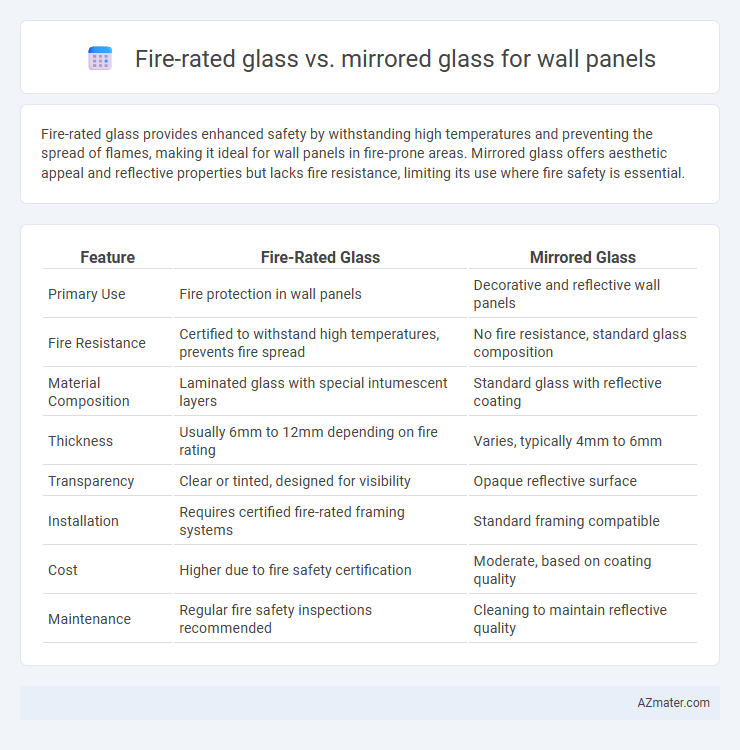Fire-rated glass provides enhanced safety by withstanding high temperatures and preventing the spread of flames, making it ideal for wall panels in fire-prone areas. Mirrored glass offers aesthetic appeal and reflective properties but lacks fire resistance, limiting its use where fire safety is essential.
Table of Comparison
| Feature | Fire-Rated Glass | Mirrored Glass |
|---|---|---|
| Primary Use | Fire protection in wall panels | Decorative and reflective wall panels |
| Fire Resistance | Certified to withstand high temperatures, prevents fire spread | No fire resistance, standard glass composition |
| Material Composition | Laminated glass with special intumescent layers | Standard glass with reflective coating |
| Thickness | Usually 6mm to 12mm depending on fire rating | Varies, typically 4mm to 6mm |
| Transparency | Clear or tinted, designed for visibility | Opaque reflective surface |
| Installation | Requires certified fire-rated framing systems | Standard framing compatible |
| Cost | Higher due to fire safety certification | Moderate, based on coating quality |
| Maintenance | Regular fire safety inspections recommended | Cleaning to maintain reflective quality |
Introduction to Fire-Rated Glass and Mirrored Glass Wall Panels
Fire-rated glass wall panels are engineered to withstand high temperatures and prevent the spread of fire, providing critical safety features in commercial and residential buildings. Mirrored glass panels enhance interior aesthetics by reflecting light and creating the illusion of space, commonly used in decorative wall applications. Choosing between fire-rated and mirrored glass depends on the balance between safety requirements and design preferences in architectural projects.
Core Differences Between Fire-Rated and Mirrored Glass
Fire-rated glass is engineered to withstand high temperatures and prevent the spread of fire for a specified duration, typically 20 to 120 minutes, featuring multiple layers including a heat-resistant interlayer. Mirrored glass primarily serves aesthetic and reflective purposes, offering no fire protection but enhancing interior design with reflective coatings on one side. The core difference lies in functionality: fire-rated glass ensures safety compliance in fire-prone areas, while mirrored glass focuses on visual appeal without meeting fire safety standards.
Fire-Rated Glass: Features and Benefits
Fire-rated glass offers superior fire resistance, typically rated from 20 to 120 minutes, providing critical time to evacuate and reduce structural damage during a fire. It is engineered with specialized interlayers that prevent heat transfer and block flames, ensuring safety without compromising natural light or visibility. This glass is ideal for wall panels in commercial and residential buildings where fire code compliance and enhanced safety are paramount.
Mirrored Glass: Features and Benefits
Mirrored glass for wall panels offers a sleek, modern aesthetic that enhances space by reflecting light and creating the illusion of larger rooms. It provides excellent privacy by obscuring views while maintaining brightness, making it ideal for both residential and commercial interiors. Its durability and ease of maintenance make mirrored glass a practical and stylish choice for decorative wall applications.
Aesthetic Considerations for Interior Wall Panels
Fire-rated glass offers a sleek, transparent aesthetic that enhances natural light flow and maintains openness in interior spaces, making it ideal for modern, minimalist wall panels. Mirrored glass provides a reflective surface that visually expands space and adds decorative depth, often used to create a luxurious or dramatic interior effect. Choosing between fire-rated and mirrored glass depends on balancing safety requirements with desired visual impact for wall panel design.
Safety and Building Code Compliance
Fire-rated glass offers superior safety by providing critical resistance to heat and flames, meeting stringent building code requirements for fire containment and occupant protection. Mirrored glass, while enhancing aesthetic appeal, lacks fire-resistant properties and typically does not comply with fire safety regulations for wall panels in commercial or multi-residential buildings. Selecting fire-rated glass ensures compliance with International Building Code (IBC) standards, contributing to overall fire safety and insurance benefits.
Durability and Maintenance Requirements
Fire-rated glass offers superior durability with heat resistance and structural integrity under high temperatures, making it suitable for safety-critical wall panels. Mirrored glass, while aesthetically appealing, is more prone to scratches and requires frequent cleaning to maintain its reflective quality. Maintenance for fire-rated glass involves periodic inspections to ensure fire protection standards, whereas mirrored glass demands careful handling to prevent surface damage.
Cost Comparison: Fire-Rated vs Mirrored Glass
Fire-rated glass typically costs 2 to 3 times more than mirrored glass due to its specialized manufacturing process and enhanced safety features, including heat resistance and impact durability. Mirrored glass panels offer a more budget-friendly option for wall applications, averaging $30 to $50 per square foot, whereas fire-rated glass ranges from $60 to $150 per square foot depending on thickness and certification level. Investment in fire-rated glass ensures compliance with stringent building codes and improved fire safety, which may justify the higher upfront cost compared to decorative mirrored glass.
Best Applications for Each Glass Type
Fire-rated glass is ideal for wall panels in commercial buildings, hospitals, and educational facilities requiring safety compliance and fire containment, offering visibility while slowing fire spread. Mirrored glass excels in aesthetic applications such as interior design in hotels, offices, and retail spaces, enhancing light reflection and creating the illusion of larger spaces. Choosing between fire-rated and mirrored glass depends on prioritizing safety regulations versus decorative appeal in wall panel installations.
Choosing the Right Glass for Your Wall Panels
Fire-rated glass offers superior safety by resisting high temperatures and preventing the spread of flames, making it ideal for walls requiring stringent fire codes compliance. Mirrored glass enhances aesthetics by reflecting light and creating a spacious feel, best suited for decorative wall panels in non-hazardous areas. Selecting the right glass involves balancing safety requirements with design goals, ensuring fire-rated glass for protection and mirrored glass for visual impact.

Infographic: Fire-rated glass vs Mirrored glass for Wall panel
 azmater.com
azmater.com